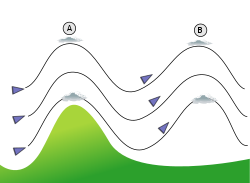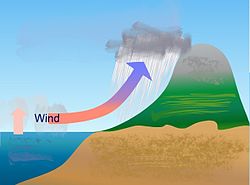
In meteorology, prevailing wind in a region of the Earth's surface is a surface wind that blows predominantly from a particular direction. The dominant winds are the trends in direction of wind with the highest speed over a particular point on the Earth's surface at any given time. A region's prevailing and dominant winds are the result of global patterns of movement in the Earth's atmosphere. [1] In general, winds are predominantly easterly at low latitudes globally. In the mid-latitudes, westerly winds are dominant, and their strength is largely determined by the polar cyclone. In areas where winds tend to be light, the sea breeze-land breeze cycle (powered by differential solar heating and night cooling of sea and land) is the most important cause of the prevailing wind. In areas which have variable terrain, mountain and valley breezes dominate the wind pattern. Highly elevated surfaces can induce a thermal low, which then augments the environmental wind flow. Wind direction at any given time is influenced by synoptic-scale and mesoscale weather like pressure systems and fronts. Local wind direction can also be influenced by microscale features like buildings.
Contents
- Wind rose
- Climatology
- Trades and their impact
- Westerlies and their impact
- Polar easterlies
- Local considerations
- Sea and land breezes
- Circulation in elevated regions
- Effect on precipitation
- Effect on nature
- See also
- References
- External links
Wind roses are tools used to display the history of wind direction and intensity. Knowledge of the prevailing wind allows the development of prevention strategies for wind erosion of agricultural land, such as across the Great Plains. Sand dunes can orient themselves perpendicular to the prevailing wind direction in coastal and desert locations. Insects drift along with the prevailing wind, but the flight of birds is less dependent on it. Prevailing winds in mountain locations can lead to significant rainfall gradients, ranging from wet across windward-facing slopes to desert-like conditions along their lee slopes.





